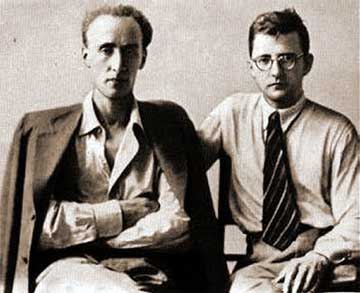Concert
Boston Philharmonic Orchestra
Benjamin Zander, Music Director
Sanders Theater
Harvard University
Cambridge, MA
Piano Concerto No. 2 in C Minor, Op. 18
George Li, piano
Dmitri Shostakovich
Symphony No. 5 in D Minor, Op. 47

Courtesy Boston Philharmonic
Piano Concerto No. 2 in C Minor, Op. 18 by Sergei Rachmaninoff
George Li, piano
Young hands with electric fingers

Lithograph by Ernst Heyn
George Li is an amazingly gifted young pianist whose technique is stunning, and he appears to play the most difficult passages without any effort at all. He has also developed a penetrating way of putting forward phrasing, giving it a sense of richness and depth.
That being said, I felt that his performance of this lyrical and popular concerto was worthy but not totally stirring. In some way, it seemed to go down a little too easily for it to be evocative. But Li is a very young man, and one would hope that, as he matures, the capacity to convey a more complex emotional fabric will also develop.
In the opening Moderato, orchestral lushness was notable from the outset; great lyricism emerged from the various strings, bringing to mind, with those large swaths of sound, the vast vistas of the Russian steppes. From within that stark landscape, a horn solo called out beautifully and longingly in the distance. The Adagio involved incredible numbers of notes, especially for the solo piano, and here Li’s great technical facility and sensitivity to tone became vividly evident. The first of the famous singing melodies for which this concerto is so well known emerges in this movement, finally yielding to a conclusion which is quiet and beautiful. In the final Allegro, the incredible grace and facility in Li’s fingers showed themselves once again, but more so. Large orchestral swaths of sound, nicely painted by Maestro Zander and the orchestra were complemented by pianistic pyrotechnics. Then, there appeared the lovely, lush, Romantic theme of that third movement, like a pledge of great love. I well noted the great precision in the violins as they echoed the mercilessly intricate piano solo, and also noted the wonderful, rich unison of the first violins while rendering that iconic theme.
Li performed two unannounced Rachmaninoff encores with seemingly effortless aplomb. The first almost sounded like a Gershwin piece, delightfully moody, with a satisfyingly tender ending. The second had an expansive lushness that was much like the Rachmaninoff concerto, but with playful rhythmic offsets.
Symphony No. 5 in D Minor, Op. 47 (1937)
by Dmitri Shostakovich
Managing somehow under Stalin

Mravinsky conducted the first performance of
Shostakovich’s Fifth Symphony
As Zander explained in his brief preface, Shostakovich, always hovering on the wrong side of the Stalinist regime and having taken some brutal criticism for his previous works, wrote this symphony to try to reinstate himself a bit in the mainstream. After Stalin himself wrote a scathing review of Shostakovich’s music in 1936, the composer, fearing execution or imprisonment, created, as he himself put it, “an artist’s answer to just criticism,” in this symphony. Poor Shostakovich – what could he do or say in the face of those dark and merciless forces? As Zander noted, Shostakovich spoke of the “many pages of music devoted to waiting for execution,” and yet, remarkably, asserted that “our business is rejoicing.”
The answer is a wonderful work that manages, somehow, to bridge the gap between more popular appeal and covert irony, conveying a broad lyricism while, at the same time, keeping hold of a subtle satirical bent in its diversionary moments, but episodically enough to keep the Stalinist authorities from frowning.
The opening Moderato showed a forceful entrance by the cellos, and then the other strings, complemented by an effective sense of searching and groping by the violins, answered provisionally by the trumpets and other brass. There followed an explosion of an exuberant circus-type music, suggesting, perhaps, something about the nature of the Stalinist regime. Machine-like hammerings emerged, calling to mind the mechanization taking place under that regime, finally devolving into a theme rendered totally in unison, also hinting, perhaps, at the totality and singularity of the authoritarian state. The Allegretto began with its elephant dance that turned quickly into weaving of a lighthearted lyricism in flute, piccolo and other winds, complemented more severely in the strings and brass. Finally, the strings entered a kind of pizzicato heaven, accompanying the winds and brass, and the whole ended dramatically and precipitously. In the Largo, the high, heartbreakingly lyrical solo by the cellos cried out for help and led, in the end, to a barely audible violin tremolo accompanying a single cembalo, a small voice, rising above the pained landscape, seeking for a ray of hope. The final Allegro involved passionate and ferocious string unisons, full of agitated energy. There were vivid interplays of themes in minor and major keys as the energy built, leading to a triumphant, majestic and stately ending.
The Boston Philharmonic played this iconic work with authority, precision and passion, and invoked, in its compelling rendering, that artful combination of grandeur, satire and despair that Shostakovich wove into its complex fabric of motives.
– BADMan
Leave a Reply